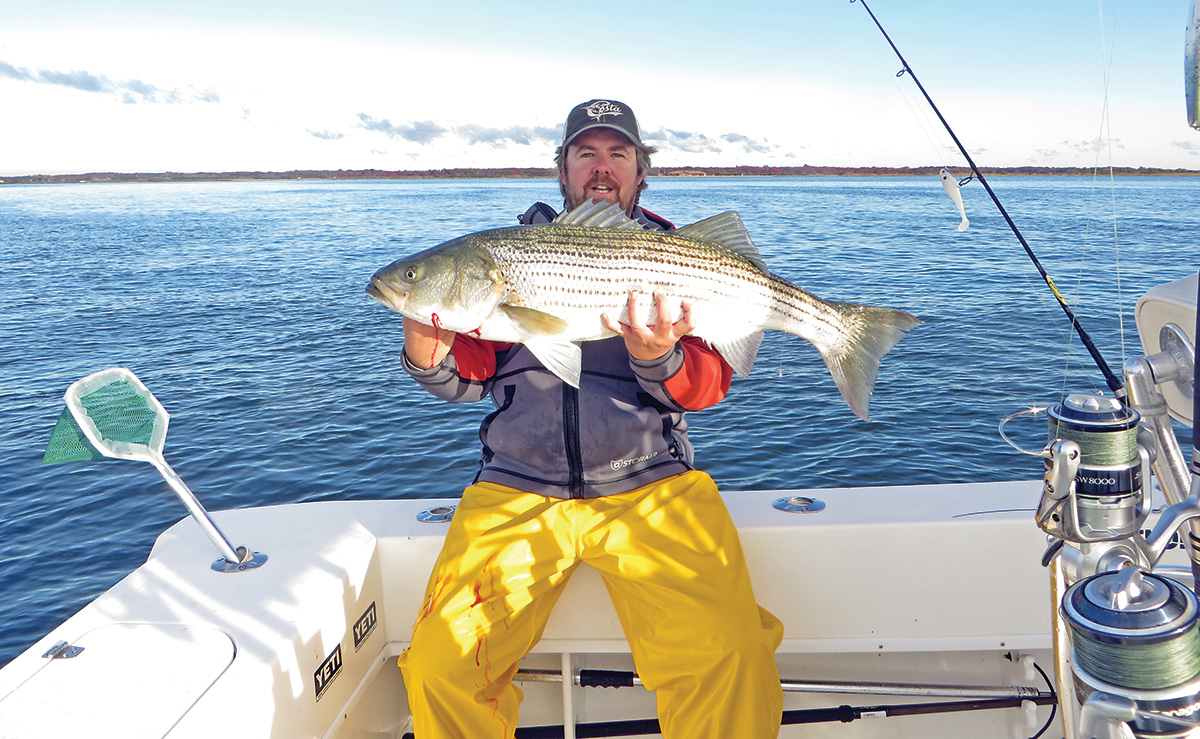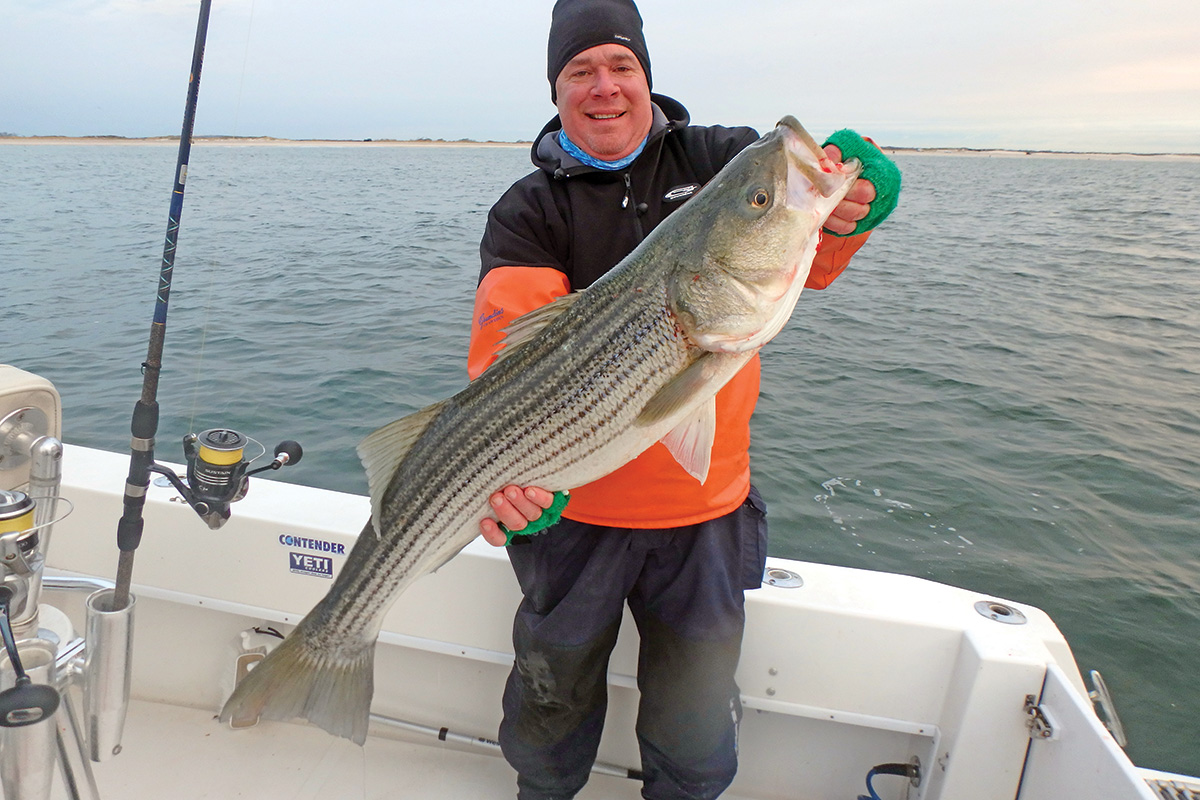
It took me two years to start to figure things out. I think I might have caught a whopping four bass the first two years that I owned a boat. I read everything I could get my hands on and watched countless videos about striped bass fishing. I have good news if you are struggling the way I use to—the fall run is about to begin. Bass will be schooled up and ready to feed. So make sure you have jigs and soft plastics on board. Below are a few of the ones I use and how I fish them.
Matching the Hatch
“Matching the hatch” is perhaps one of the most frequently used phrases when talking fishing. To be honest I didn’t really believe it until I took a trip to Montauk one late September morning about 10 years ago. Through an online forum I got an invite to fish Montauk. To this day I remember I couldn’t sleep the night before, realizing I was only a few hours away from fishing Montauk in the fall. In the early hours of the morning it was time to head out. I could hardly sit still as the hour and half car ride out to Montauk seemed to take forever. Once there we jumped on a 21-foot center console and pushed off. As we headed out I turned to the captain and asked him if he thought we would catch a few fish today. He chuckled and never answered me. I would quickly find out why he laughed at my question.
As we came around the point my eyes nearly popped out of my head. I don’t think I blinked for a good 10 minutes. There were birds and fish everywhere. Boats were zooming and zipping, running ‘n’ gunning all around. We quickly positioned ourselves right next to total chaos. Until that trip I had never really seen a blitz. Cast after cast, nothing. I couldn’t believe that I couldn’t hook up. The frustration was building and at that point; I didn’t know what to do, but thankfully the captain did. He pointed out that the bass were feeding on “rain bait.” The lures that I was throwing were way too big. He told me “you need to match the hatch.” So he handed me another rod with small lure on it, and I started to catch a fish on every cast. I mean every cast.
Looking back it seemed so simple. I still use the rig that the captain introduced me to. It consisted of a 2-ounce in-line/drail sinker tied to your main line. Connect 3 feet of 20-pound fluorocarbon leader to the other end of your sinker. At the end of the leader use a 1/2 ounce jighead with a 2- or 3-inch soft plastic swim bait. This rig allows you to match the hatch while the inline/drail sinker allows you to cast it further and keep it below the surface. This rig works great in the ocean. However when it comes to fishing the bay and the ocean I usually use different lures and techniques.
Bay Bassing
When it comes to bass fishing in the bay during the fall I have two “go-to” lures. Last year I started to experiment with using a spoon (Krocodile type) inside the bay and had great success. I wanted something shiny that I could cast a long distance so I settled on using a spoon. The wobble action of the spoon draws a lot of attention. I found the 2-ounce model worked best. Whichever spoon you decide to use, make sure it stays below the surface. A silver metallic spoon resembles a fleeing peanut bunker or mullet. Once again you are trying to match the hatch. The ability to cast this lure from a great distance keeps you from putting down the fish with your boat.
The other must have lure is a soft plastic, and there are many to choose from: Hogy, Bass Assassins, Gulp, Zman. I can go on and on but my personal favorite is the 6-inch Tsunami swim shad. They do an excellent job mimicking peanut bunker. I like the 6-inch model because they weigh between 2 and 3 ounces, which allows them to be cast a long way. My go to color is pearl. Other colors do work but I find my hook up ratio is much higher when I use pearl. If you can’t find the Tsunami brand, Storm and Panther Martin also make excellent swim shads. Swim shads can be fished in very shallow water. I can’t tell you how many times I’ve looked at my depth finder to see only 2 feet of water. The key to catching bass that are feeding in really shallow water is how quickly you begin your retrieve. As soon as that swim shad hits the water you should be turning the handle. You don’t want your lure to get covered up with weeds dragging on the bottom.
Along the Oceanfront
When bass are feeding on rain bait in the ocean I use the rig that I mentioned earlier when retelling the Montauk experience. There are two other great lures that I use when bass are on small bait especially when it’s windy. A Deadly Dick and a Hogy Heavy Minnow both fit the profile of small bait. These lures cut through the wind with ease. I also use the same types of soft plastics in the ocean that I use in the bay. When it comes to using soft plastics in the ocean there are two types of scenarios that I use them. If I spot birds or surf fishermen clustered together along the shore I throw a soft plastic towards the beach. I also throw a soft plastic to bass feeding on the top.

Once the blitz on top stops doesn’t mean the fish are gone. It’s then time to grab the rod that is set-up with a jig. I don’t want to insult anyone, but dunking a clam or a bunker chunk while on anchor doesn’t do it for me. The tug is the drug. Bass jigging is very addictive. There are two jigs that I use. The first is a butterfly jig. I use this jig when bass are feeding on herring, bunker or mackerel. Its flutter effect makes the jig look like an injured fish. Keep in mind these jigs are on the pricey side. Personally, if bluefish are mixed in with bass I would not run the risk of losing a $15-jig. The other jig is what I use most of the time. It’s just an old school diamond jig. I don’t bother with the colored tubes that most anglers seem to prefer. When bass are on sand eels you would be hard pressed to find a more effective way to catch bass. A great feature of the diamond jig is just how long it could be used for. As long as you don’t get bit/broken off the jig continues to produce year after year. If the hook rusts just take it off and put on a Gamakatsu Siwash (open eye) hook.
There are two ways to fish a diamond jig. The first way is to drop it to the bottom and “bounce” it. You do this by raising the rod tip up and then dropping it down. This is not the technique that I use. The reason why I don’t use this technique is because you are going to end up catching skates, dogfish and just a few striped bass. I drop my jig to the bottom and reel it three quarters of the way up. I then repeat the process over and over. This method takes some effort, but I guarantee it will out fish the “bottom bouncer” every time. A lot of time, money and effort is put into fishing trips, so don’t be lazy. Drop and reel! If you noticed, I didn’t mention anything about using a diamond jig in the bay. I have tried and concluded that if I’m not fishing in at least 30 feet of water the jig just doesn’t seem to produce. My gut feeling is by the time the bass chase it up they can already see the boat and turn away.
Remember that a lure that works in the bay may not produce the same when you are fishing in the ocean and vice-versa. It’s important to recognize what bass are feeding on. If you take one thing from this article I hope you realize just how important it can be to match the hatch.





